In the ever-evolving landscape of digital media, the fusion of artistic design and user experience has given rise to a new realm of interactive content. This innovative blend not only captivates the audience with its visual allure but also engages them in a dynamic participatory experience. By exploring examples of interactive content, we can uncover the profound impact of this fusion on both creators and audiences alike.
The Essence of Interactive Content
Interactive content stands at the intersection of technology, art, and user engagement. It is defined by its ability to involve the audience in the narrative or presentation, transforming passive viewers into active participants. This engagement is achieved through various forms, including but not limited to interactive storytelling, gamified experiences, and immersive environments. The core aim is to create a two-way dialogue between the content and its users, fostering a deeper connection and a memorable experience. Here are some examples:
1. Interactive Documentaries
Interactive documentaries, such as “Bear 71,” challenge traditional storytelling by allowing viewers to navigate through the story in a non-linear fashion. This documentary about wildlife in Canada uses interactive maps, motion-sensitive cameras, and narrative choices to immerse the viewer in the life of a grizzly bear named Bear 71. The audience’s choices can lead to different understandings and emotional impacts, showcasing the power of interactive art to convey complex messages about nature and technology.
2. Virtual Reality Art Installations
Virtual reality (VR) art installations offer a deeply immersive experience that transports users into entirely new worlds. For example, “The Night Café,” an interactive VR experience, allows users to step into a Vincent van Gogh painting, exploring the room with a 360-degree view and interacting with objects within the space. This merging of classic art with modern technology invites users to experience art in a way that is both personal and profound.
3. Interactive Music Videos
Music videos have also embraced interactivity, offering viewers a chance to influence the visual and auditory experience. Björk’s “Stonemilker” VR music video, for instance, enables users to control the direction and focus of the video, creating a personalized journey through the music and visuals. This example illustrates how interactive content can enhance the emotional resonance of music by involving the audience in its presentation.
4. Educational Games and Simulations
Educational games and simulations merge learning with interactive design to create engaging experiences that both inform and entertain. “Zooniverse” is a platform that allows users to contribute to real scientific research through simple tasks within the context of a game. By participating in these activities, users not only learn about the subject matter but also contribute to the advancement of knowledge, highlighting the potential for interactive content to make meaningful impacts beyond entertainment. Here are some examples:
The Impact on User Experience
The fusion of art and user experience through interactive content has profound implications. It not only elevates the aesthetic and emotional depth of digital media but also redefines the role of the audience. By engaging users in a dialogue, interactive content fosters a sense of agency and participation that traditional media cannot replicate. This engagement leads to more memorable and meaningful experiences, encouraging users to explore, question, and connect with the content on a deeper level.
The Future of Interactive Content
As technology continues to evolve, the possibilities for interactive content are boundless. Emerging technologies such as augmented reality (AR), artificial intelligence (AI), and advanced data visualization offer new avenues for creativity and engagement. The future of interactive content lies in its ability to blend art, technology, and user experience in ways that inspire, educate, and connect us.
In conclusion, the merger of artistic design with user experience through interactive content represents a significant shift in the digital landscape. By showcasing examples of innovative interactive content, we can appreciate the immense potential of this fusion to transform how we create, consume, and interact with digital media. As we continue to explore this exciting frontier, the possibilities for creativity and connection are limitless.

Leave a Reply
You must be logged in to post a comment.